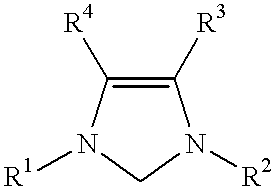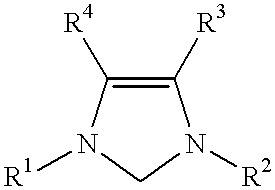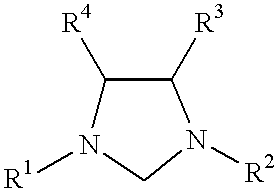Use of a catalyst system comprising nickel palladium or platinum and imidazoline-2-ylidene or imidazolidine-2-ylidene in stille coupling reactions
a catalyst system and stille coupling technology, applied in the preparation of amino compounds, physical/chemical process catalysts, organic compounds/hydrides/coordination complex catalysts, etc., can solve the problems of requiring the use of more expensive aryl bromides and aryl iodides, prior art methods generally cannot employ aryl chlorides as feedstock for these chemical transformations, and achieve good yield effects
- Summary
- Abstract
- Description
- Claims
- Application Information
AI Technical Summary
Benefits of technology
Problems solved by technology
Method used
Image
Examples
example 1
For each run, a Schlenk tube was charged with Pd.sub.2 (dibenzylideneacetone).sub.3 (28 mg, 0.03 mmol), 1,3-bis(2,6-diisopropylphenyl)imidazolinium chloride (25.5 mg, 0.06 mmol), CsF (334 mg, 2.2 mmol), and a magnetic stirring bar. After a 30 minute catalyst activation period, 1,4-dioxane (3 mL), an aryl chloride (1.0 mmol each) or an aryl triflate (1 mmol), and (C.sub.6 H.sub.5)Sn(CH.sub.3).sub.3 (1.05 mmol) were added in turn to the Schlenk tube. The Schlenk tube was placed in a 100.degree. C. oil bath and stirred for 48 hours. The mixture was then allowed to cool to room temperature. The mixture was washed with diethyl ether. The organic layer and the diethyl ether extracts were combined, washed with saturated saline solution, and then dried over MgSO.sub.4. The solvent was removed under vacuum and the residue was purified by flash chromatography using hexane or a mixture of hexane and ethyl acetate.
The aryl chlorides or aryl triflates used in each run are listed in Table 1. All ...
example 2
Reagents, analyses, and procedures were as described in Example 1, except as follows. The aryl chloride used in both runs was methyl-4-chlorobenzoate (1.0 mmol); different organotin compounds (1.05 mmol each) were used. The organotin compound used in each run are listed in Table 2. All of the yields reported in Table 2 are of the heterocoupling product, and are the average of two runs.
It is to be understood that the reactants and components referred to by chemical name or formula anywhere in the specification or claims hereof, whether referred to in the singular or plural, are identified as they exist prior to coming into contact with another substance referred to by chemical name or chemical type (e.g., another reactant, a solvent, etc.). It matters not what preliminary chemical changes, transformations and / or reactions, if any, take place in the resulting mixture or solution or reaction medium as such changes, transformations and / or reactions are the natural result of bringing the...
PUM
| Property | Measurement | Unit |
|---|---|---|
| temperature | aaaaa | aaaaa |
| temperature | aaaaa | aaaaa |
| temperature | aaaaa | aaaaa |
Abstract
Description
Claims
Application Information
 Login to View More
Login to View More - R&D
- Intellectual Property
- Life Sciences
- Materials
- Tech Scout
- Unparalleled Data Quality
- Higher Quality Content
- 60% Fewer Hallucinations
Browse by: Latest US Patents, China's latest patents, Technical Efficacy Thesaurus, Application Domain, Technology Topic, Popular Technical Reports.
© 2025 PatSnap. All rights reserved.Legal|Privacy policy|Modern Slavery Act Transparency Statement|Sitemap|About US| Contact US: help@patsnap.com



